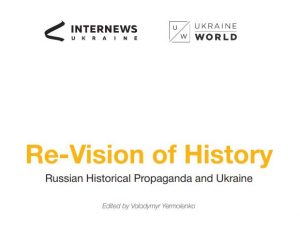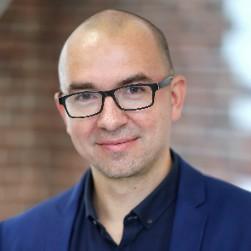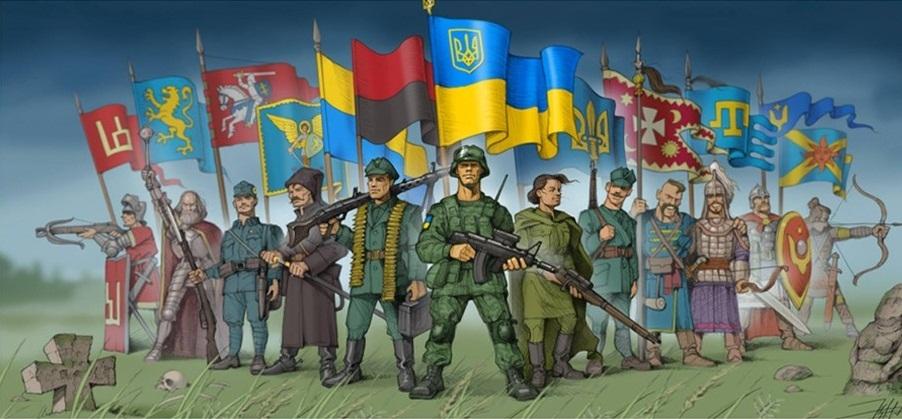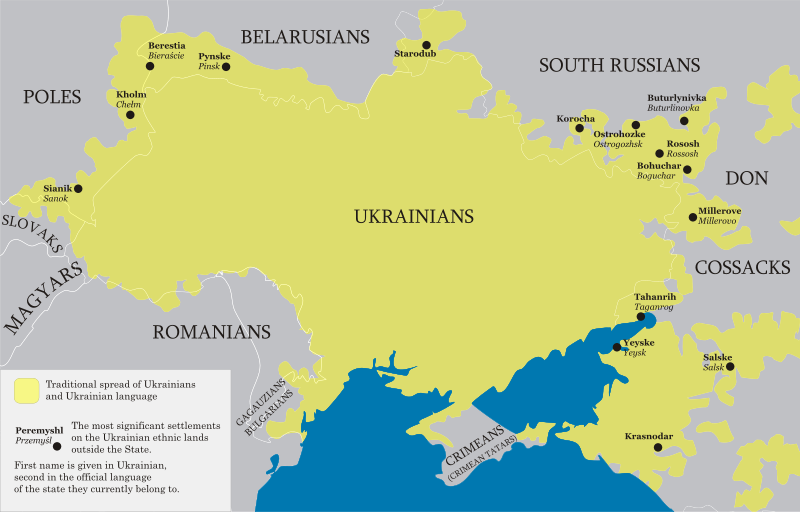
"Russian historical propaganda is not only misinformation and fake news. It is much more complicated. It uses a mixture of facts and fiction, knowledge and manipulation. In its new form, it is an attempt to validate Russia’s narrative and devalue the opponent's narrative through simplistic and unambiguous theses, often backed up by strong emotions," said Oksana Ilyuk, an analyst at Internews-Ukraine.
Describing the method of analysis, Oksana Iliuk said that they started with a background analysis of Russian propaganda in general to create a list of key words. Then with the help of artificial intelligence, the team found thousands of posts containing Russian propaganda. At the final stage, historians went through these posts, read and analyzed them. The project didn’t have the goal of debunking Russian fakes. Rather it explained how Russia uses history for its political goals and what narratives it employs with the help of common historical facts .

Volodymyr Yermolenko, head of the analytical department at NGO Internews Ukraine summarized the Russian disinformation narratives into two categories: "the illegal annexation of Crimea was justified because ‘Crimea had always been Russian’ and that ‘it was a shrine of Russian Christianity.’ The Russian aggression in the Donbas was justified because the Donbas became part of Ukraine ‘by accident’ and that only ‘Russian-speaking’ people live there, who are about to be destroyed by ‘Ukrainian Nazis’ because ‘all Ukrainians are Nazis’.”
The analysis of Russian narratives with the use of artificial intelligence and book preparation were conducted by Internews Ukraine and UkraineWorld. The comments of Ukrainian historians about narratives were provided by experts of the project LikBez: Historical Front, and by well-known Ukrainian historian and intellectual Yaroslav Hrytsak.
Below we publish a short overview of the main narratives of Russian propaganda with the comments of Ukrainian historians. The book is distributed free of charge and you can download the full e-copy here.
Narrative 1. “Ukraine is a failed shadow of Russia”
Outskirt. “Ukrainians do not exist as a nation” – this is the beginning of a post in the Russian social network VK. The author of the post believes that an attempt to make a statement about the separate Ukrainian nation is a manipulation with the goal to “tear off part of the Russian lands from Russia, and weaken Russia in the future.” Russian commenters often try to profit from the linking of the name of Ukraine (Ukrayina) to the word okrayina (outskirts).
There are several versions of what the name “Ukraine” means. One of the most common is simple — that Ukrayina
is derived from the word krayaty (separate) and means kray, krayina, which is “land” or “our spearate land” - a quite common logic for many countries’ names worldwide. Yet, even if one applies the okrayina (outskirt) version, which is also popular among scholars, history will remain far away from Russian interpretation.
In the first mentioning of the name “Ukraine” in 1187 (Kyiv Chronicle) if it meant “outskirt,” “border,” “frontier,” then it was the “battle border” or “military border.” But whose “border” was it? In the Middle Ages, this word meant the “border of the Rus land.” The “Rus land” meant the lands around Kyiv, the capital and the “oldest city” of the Rurik dynasty empire. In other words, the medieval “ukrayina” was, in fact, the “outskirts of Ukraine,” “okrayina of Ukraine.” The “battle border,” and the idea of the “defense of the native land” added an emotional connotation to this word, which achieved a new level of popularity in the 17th century, during the Kozak era.

Ukrainians are Rus-sians. According to this point, there was one nation living on the lands of the entire Rus that had a common culture, language, and history since the 9th century, and which has been called “Russian” since then. “Before the [Bolshevik] revolution, it was called a triune Russian nation consisting of Little Russians, Belarussians, and Great Russians,” a Russian publicist wrote in VK. Russian propaganda also says that only Russia deserves to be called the successor of Kyivan Rus while Ukraine and Belarus lost this right because they lost their independent states in the 14th century.
But in fact, the lands of contemporary central Russia were called Rus for the first time in sources in 1238, whereas Kyiv was called “the Mother of Rus cities” from 882. This is an obvious “traumatic experience” for the Russian historical model. To defend the Russian imperial historical narrative, Russians say that Kyivan Rus was later followed by a Muscovite Rus, in other words, claimed that there was a translatiо imperiae (a transferal of the empire). However, by that logic, Lithuanian and Polish states of the 14-15th centuries can also claim they’re successors of Rus, since they absorbed half of its lands, peoples, and culture.
The Ukrainian church has no right to independence. Russian propaganda argues that there is only one canonical church in Ukraine – the Ukrainian Orthodox Church of the Moscow Patriarchate, which is subordinate to the Russian Orthodox Church. The Tomos legalizing the autocephaly (independence) of the Ukrainian Orthodox church was granted to schismatics and, thus, it has legitimized the schism instead of healing it. Russian information outlets also refer to the fact that Moscow church leaders continued to bear the title of “Metropolitans of Kyiv.”
Ukrainian historians provide arguments in favor of independence of Ukrainian church both related to the church’s history (Kyiv received Christianity from Constantinople), and to the modern logic of Eastern Christianity (sovereign states usually receive their autocephalous church).
Narrative 2. “Ukraine is an artificial project of the West”
Ukraine is a “project” of Western countries aimed at weakening Russia. According to Russian historians, no one called themselves “Ukrainians” because everyone, in the words of ancient chroniclers, belonged to the “russkyi” people. The invention of the “Ukraine” concept, according to statements made by some Russian authors, belongs to a Pole, Jan Potocki. In 1795, he said that Ukrainians have a different origin than Russians. Later his idea, these authors say, was developed by another Pole, Tadeusz Czacki and Austrians “for playing off one Russian against another Russian.”
Yaroslav Hrytsak, a prominent Ukrainian historian, answers that all nations and states are “projects.” The question is not whether the nation is a “project” or not but whether this project is sustainable, viable, and whether it’s able to survive. The Ukrainian political project that survived wars, Holodomors, repressions, and external aggressions, proved its right to life. On average, only 1 of 10 national projects succeed, according to Hrytsak.
The fact that Poles, Austrians, Germans, Jews, Bolsheviks, Stalin, and Hitler were interested in the Ukrainian project only demonstrates its power and importance for the world political order. Other national projects have taken Ukraine into account and this is a success. Hrytsak also says that Stalin played the “Ukrainian card” better than Hitler. This was an important factor in Stalin’s victory in WWII and also evidence that often Russians tried to use the Ukrainian national project against Poles or Austrians.
The Ukrainian language is artificial.
Russian historians claim it had its origins in Russian but later separated itself from it, or it was created by the Poles, Austrians, or Jews. The Russian information agency Rex published an article that was shared actively by users of Russian social networks VK and OK. The article explains that the “Ukrainian language is a weapon in the hybrid war,” commenting on the quotas on the Ukrainian-language content for radio and television used as “brain programming” technology.
It is impossible to suddenly “invent” a language spoken by 35 million mostly illiterate peasants in the early 20th century. Today’s linguistic studies point towards the uninterrupted development of the Ukrainian language since the disintegration of the Slavic linguistic unity of the 5th-6th centuries. This development went through the stage of proto-Ukrainian dialects and then to the emergence of the modern standard literary language. Russian propaganda also states that the Ukrainian language is the “Russian language” which was “Polonized” and “humiliated.” But languages are often subject to foreign influences, and the Ukrainian language is no exception. It was subject to influences from Bulgarian in the 10th-12th centuries; from Polish in the 16th-17th centuries; from Russian in the 18th-19th centuries; from English in the 20th-21st centuries. The Russian language is subject to foreign influences too.

Narrative 3. “Crimea, Donbas, and South-East of Ukraine belong to Russia”
Crimea has always been a Russian territory. In his “Crimean address,” Putin mentioned that “...in the heart, in the mind of people, Crimea has always been and still is an inseparable part of Russia.” The myth about Crimea as a territory that has always been part of Russia is based on the earlier annexation of the Crimean Khanate by the Russian Empire in 1783. The transfer of Crimea to the Ukrainian Soviet Socialist Republic by Nikita Khrushchev in 1954 is interpreted by Russian propaganda as a “mistake,” “formality” or even an illegal act.
In their response, Ukrainian historians claim that Crimea belonged to Russia only for 5.6% of its written history (instead, it belonged to the Crimean Khanate for 11.4% of its history); Russians constituted a relative majority in Crimea only for 4% of its written history, and the absolute majority only for 2.5%


Donbas and “Novorossiya” are part of the “Russian World”. Joseph Stalin, otherwise praised by many Russian propaganda outlets, is criticized for “giving Donbas to Ukraine.” In the Russian and pro-Russian segments of the Russian social network VK that Internews Ukraine analyzed, a lot of posts address the issue of “bringing back lands that were originally Russian,” meaning not only Donbas but also whole south-east of Ukraine.
Ukrainian historians comment that Donbas traditionally had its own regional identity although again the majority of its population were and still are Ukrainians. The myth about “Novorossiya" is related to the history of colonization of the Black Sea and the Azov territories by the Russian Empire in the 18th century. However, the principal driving force of that colonization was Ukrainian peasants and not Russians.
Narrative 4. “USSR was a powerful empire, and Stalin was a hero”
The USSR was a powerful empire, but Ukrainians neglected its achievements. Russian historical propaganda often stresses that the USSR was a powerful industrial and military empire. According to some Russian propaganda messages, the USSR transformed itself from a poor country into a powerful industrial giant, a global super-state, while today’s Ukrainians neglect its achievements although they continue to use its potential. A powerful cult of Stalin began to develop recently in the Russian media. It is frequently emphasized how important this person was for the “USSR’s success,” and that during the period of his rule the country achieved its highest development. One of the messages is that it was due to his military genius that the USSR was able to win World War II.
In fact, the USSR perished because of the inefficiency of its economic model and the artificial nature of its ideology. Russian modernization led to a dead-end, and the task of overcoming its consequences remains a difficult economic and social problem for contemporary Ukraine.
Moreover, industrialization in the USSR cost a tragic price:
- approximately 1 million victims of the 1921 famine;
- nearly 1 million victims of the 1917—1921 civil war;
- 3,900,000 people who died during the 1932—1933 Holodomor;
- approximately 1 million victims of the 1946 famine — and this list can be continued.
Read also: Was Holodomor a genocide? Examining the arguments
It was Stalin who created modern Ukraine. Russian historians also say that Stalin “presented” Bessarabia, Zakarpattia, Crimea, and Galicia to the Ukrainian SSR and, therefore, expanded Ukrainian land significantly.
Answering this claim, Yaroslav Hrytsak starts with an earlier fact. There is a well-known discussion between Rosa Luxemburg and Lenin in 1918. In this debate, Rosa Luxemburg accused Lenin of he was flirting with Ukrainian nationalism. Lenin replied in the following way: “Have you looked at the map of elections, where the constituent meetings were held in the autumn of 1917? Was it a coincidence that Ukrainian, and not Russian, socialist parties won in the Ukrainian provinces? How can you ignore the territory where the majority of people vote not for us, but for the Ukrainians?”
The USSR in general and Ukrainian SSR in particular were a union of two forces – the Russian Bolsheviks in the center and national movements in the periphery. None of these two forces had sufficient power to establish unilateral control over the non-Russian periphery. This temporary alliance came to an end in 1929 after the wind-down of Ukrainization and the beginning of Stalin’s plan. Stalin destroyed the resistance of Ukrainian villages, organized artificial Famine, repressions, and so on. Yet, when WWII began, the Ukrainian question became a foreign issue, not a domestic one. Everyone tried to manipulate it. Stalin turned out to be the most skillful player in the Ukrainian card game including Ukrainian lands to Ukrainian SSR and in that way mobilizing more people.
Narrative 5. “All Ukrainian nationalists were fascists”
“UPA (Ukrainian insurgent army) served Hitler.”
Russian historical propaganda often claims that there was no difference between the Ukrainian nationalism of the 1930s–1940s and German Nazism. It is often said that those who believe they are Ukrainian nationalists today are, in fact, “spiritual descendants of military criminals, fascists, and Nazis.” Ukraine, after the Revolution of Dignity of 2014 is, in the eyes of Russian propaganda, a place where fascism is back. One of the messages says that OUN and UPA members “were the principal executors in Lviv death camps where 120,000 Jews were killed.” It is also said that although “the role of simple servants of Arian masters was prepared for them, OUN leaders continued close cooperation with the occupying authorities.”
Ukrainian historians claim that no one insists that some of OUN-UPA fighters didn’t commit crimes including in the Holocaust, especially in the initial part of WWII. However, this does not annul the fact that OUN and UPA made up the Ukrainian national liberation movement and fought against both Nazis and Bolsheviks.
It is true that during a certain period OUN had sympathy towards the Nazis and wanted to cooperate with them to restore Ukrainian statehood. But let’s not forget that before 1939 Nazi Germany had not yet committed the terrible crimes of the Holocaust and mass killings. It was the USSR and Stalin, who was the notorious “leader” with regard to the mass extermination of people at that time.

Some statements made by Russian propaganda have been already refuted. For instance, the participation of Bukovyna kurin – an armed group of OUN(m) – in the mass shootings of Jews in Babyn Yar was refuted. Contrary to the statements of Russian propaganda, UPA and nationalists never served as guards at Nazi concentration camps.
“Glory to Ukraine!” slogan is a copy of the Nazi slogan “Heil Hitler!” Some VK users often disseminate the statement that the “Glory to Ukraine!” greeting, which became widely popular during the Euromaidan of 2013–2014, is related to “the development of Ukrainian Nazism.” Due to the popularity of this slogan, “Ukrainian Nazism” allegedly received a new boost: “The neo-Nazi greeting, Glory to Ukraine! and the response Glory to Heroes! will become the official greetings in the Independent [Ukrainian] army,” one of the messages reads.
In reality, however, the slogan ‘Glory to Ukraine! Glory to Heroes!’ does not belong to the OUN. This slogan appeared earlier, during the 1917–1918 revolution, long before Hitler.
Narrative 6. “Ukraine forgot about the victory over Nazism”
In their response, Ukrainian historians emphasize that Ukraine stepped away from the Soviet interpretation of the 1945 victory because
- for Ukraine, the war started not in 1941, but in 1939;
- Ukraine stresses not only the importance of victory, but the huge number of victims caused by this war, including the unjustified victims who perished at the hands of the Soviet regime itself.
Approximately 7,000,000 representatives of Ukraine fought for the Red Army, which makes up approximately 23% of the entire size of the Armed Forces of the USSR. The overall losses of the Red Army totaled 8.6 million people, of which Ukrainians accounted for nearly 3.5—4 million. As to portraying Russia as the only “liberator” of Europe, Ukrainian historians emphasize that out of all Soviet republics, Ukraine and Belarus suffered the most as a result of the war.
- Read also: Understanding the Ukrainians in WWII. Part 1
One more question to consider is whether the victory over Nazism was indeed a victory for Ukrainians. There are diaries and letters of German soldiers from the Eastern front. One German officer who was in Ukraine in summer 1941 wrote that the Ukrainians gave a hospitable welcome to the Germans. It looked like the Ukrainians were “the last nation in Europe that still loves us,” he said. There were reasons for that. It was not love for Germany. It was the hope of many Ukrainians that the German army would liberate them from Stalin and Stalin’s regime. Of course, they found that this was an illusionary hope. In the end, whoever would have won WWII, Ukrainians would be called collaborators anyway.
Read also:
- Top-6 Soviet World War II myths used by Russia today
- The Soviet foundations of Russia’s Great Patriotic War myth
- The Holodomor of 1932-33. Why Stalin feared Ukrainians
- Moscow completely restores and promotes Stalinist conception of WW2, Pavlova says
- How Soviet troops destroyed downtown Kyiv and killed Kyivans in 1941
- Ukraine, the Gates of Europe of the last millennia, and their meaning for Russia – Serhii Plokhy explains
- New book tells of sacred relics of Kyivan Rus appropriated by Russia
- “Malorossiya”: yet another Russian imperial myth salvaged from the garbage dump of history

